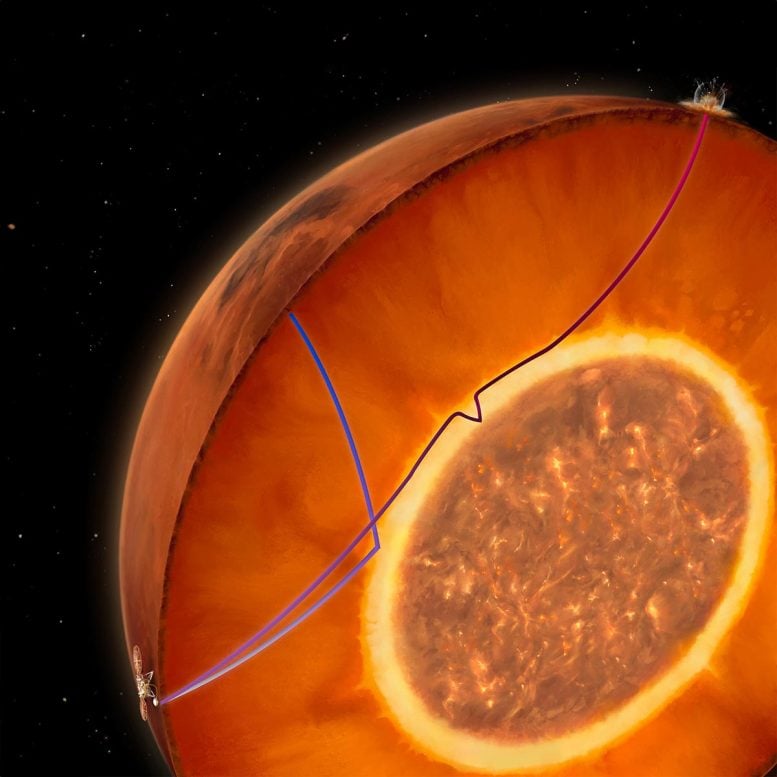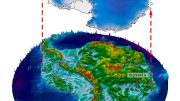
Artist’s view of Mars’ interior structure showing a molten layer at the base of the mantle and above the core. The purple line shows the path followed in Mars by the waves generated by the meteorite impact that occurred on September 2021 and diffracted along the CMB. The blue line represents the path followed by a seismic wave reflected at the top of the molten basal layer. Credit: IPGP / CNES / N. Starter
Recently, a team of scientists involved in NASA’s InSight mission completed an analysis of seismic data recorded on Mars after a meteorite impact that occurred in September 2021. Their findings drastically change our view of the internal structure and evolution of the Red Planet.
Based on these results and previous geophysical data, a study published in the journal Nature, in which researcher Attilio Rivoldini from the Royal Observatory of Belgium participated, proposes a new model for the interior of Mars, with a heterogeneous mantle containing a molten silicate layer above the liquid metal core.
Initial Findings and Assumptions
The first results based on data from the InSight mission significantly improved our knowledge of the interior structure of Mars. Assuming that the mantle is compositionally homogeneous and entirely solid, the results showed that the liquid metal core has a radius of about 1830±40 km and a relatively low density (6-6.2 g/cm3) with a large concentration of light elements. The size of the metal core was determined by the detection of seismic waves reflected at a solid-liquid interface ascribed to be the Core-Mantle Boundary (CMB).
Re-Evaluation After Recent Impact
However, since then, the analysis of new data generated by a powerful meteorite impact that occurred on September 18, 2021, questioned the first estimates of the internal structure of the Red Planet. An international team led by Henri Samuel, CNRS researcher at the Institute of Globe Physics in Paris, and involving Attilio Rivoldini from the Royal Observatory of Belgium, studied the propagation times of these waves and showed that a molten silicate layer at the base of the Martian mantle and above the metallic core can explain the new data.
Based on this finding, a new structure model has been deduced and published on October 26 in the journal Nature. That structure model is not only more consistent with all available geophysical data, but also explains better the evolution of Mars since its formation.
Seismic Anomalies Explained
A molten layer at the base of the mantle elucidates the abnormally slow propagation, hitherto unexplained, of seismic waves diffracted along the CMB in September 2021. Furthermore, for several earlier seismic events, the arrival times of seismic waves are compatible with reflections of seismic shear waves at the top of the molten layer (located several tens of kilometers above the metallic core) and not at the CMB, as previously assumed.
Implications for Core Size and Composition
The presence of this molten layer at the base of the mantle implies that the metallic core is 150 to 170 km smaller (i.e., a radius of 1650±20 km) than previous estimates.
“This smaller core is also 5 to 8% denser (i.e. 6.5 g/cm3). The fraction of light elements in the core is lower than previously thought and as such is more compatible with cosmochemical data deduced from the analysis of Martian meteorites and high-pressure experiments,” explains Attilio Rivoldini.
Mars’ Early Evolution
The authors of the study therefore propose that Mars experienced an early magma ocean stage whose crystallisation produced a stable layer at the base of the mantle, highly enriched in iron and radioactive elements. The heat released by radioactive decay generated a basal layer of molten silicates above the core.
For more on this study:
- NASA’s InSight Lander Uncovers Mars’ Molten Mystery
- Decoding the Red Planet’s Core Mystery
- Scientists Discover Molten Layer Covering Martian Core
Reference: “Geophysical evidence for an enriched molten silicate layer above Mars’s core” by Henri Samuel, Mélanie Drilleau, Attilio Rivoldini, Zongbo Xu, Quancheng Huang, Raphaël F. Garcia, Vedran Lekić, Jessica C. E. Irving, James Badro, Philippe H. Lognonné, James A. D. Connolly, Taichi Kawamura, Tamara Gudkova and William B. Banerdt, 25 October 2023, Nature.
DOI: 10.1038/s41586-023-06601-8
About InSight and SEIS:
NASA’s InSight mission officially ended in December 2022 after more than four years of collecting unique science data on Mars.
JPL managed the InSight mission on behalf of NASA’s Science Mission Directorate. InSight is part of NASA’s Discovery program, managed by the Marshall Space Flight Center (MSFC), NASA’s Huntsville, Alabama facility. Lockheed Martin Space in Denver built the InSight probe, including its cruise stage and lander, and supported operation of the spacecraft for the mission. CNES was the prime contractor for SEIS and the Paris Institute of Globe Physics (Université Paris Cité/IPGP/CNRS) assumed scientific responsibility. CNES finances the French contributions, coordinates the international consortium (*) and was responsible for the integration, testing and supply of the complete instrument to NASA. IPGP designed the VBB (Very Broad Band) sensors, tested them before their delivery to CNES and contributes to the operation of VBBs on Mars.
The SEIS and APSS operations were carried out by CNES within FOCSE-SISMOC, with the support of the Centro de Astrobiologia (Spain). SEIS data are formatted and distributed by the Mars SEIS Data Service of IPG Paris, as part of the National Observation Service InSight to which LPG also contributes and, for Seismo activities at the School, GéoAzur. Daily identification of earthquakes was carried out by InSight’s Mars Quake Service, a collaborative operational service led by ETH Zurich to which seismologists from IPG Paris, the University of Bristol (UK) and Imperial College London ( UK).
Several other CNRS laboratories including LMD (CNRS/ENS Paris/École polytechnique/Sorbonne University), LPG (CNRS/Nantes University/Le Mans University/University of Angers), IRAP (CNRS/University of Toulouse/CNES ), the LGL-TPE (CNRS/École Normale Supérieure de Lyon/Claude Bernard University Lyon 1), the IMPMC (Sorbonne University/National Museum of Natural History/CNRS) and LAGRANGE (CNRS/Université Côte d’Azur/Observatoire of the Côte d’Azur) are participating with the IPGP and ISAE-SUPAERO in the analysis of data from the InSight mission. These analyse are supported by CNES and the National Research Agency as part of the ANR MArs Geophysical InSight (MAGIS) project.
(*) in collaboration with SODERN for the production of the VBB, the JPL, the Swiss Federal Institute of Technology in Zurich (ETH, Zurich Switzerland), the Max Planck Institute for Solar System Research (MPS, Göttingen, Germany), the Imperial College London and the University of Oxford provided the SEIS subsystems and are involved in the scientific exploitation of SEIS.









Be the first to comment on "Mars’ Hidden Molten Layer: A New Peek Beneath the Martian Mantle"